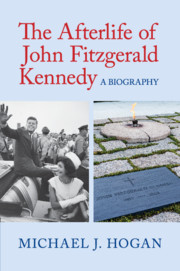Book contents
- Frontmatter
- Dedication
- Contents
- Acknowledgments
- List of Abbreviations
- 1 The Afterlife of John Fitzgerald Kennedy: An Introduction
- 2 All the World's a Stage: Constructing Kennedy
- 3 From History to Memory: Assassination and the Making of a Sacred Symbol
- 4 Ritual and Remembrance: Cultural Trauma, Collective Memory, and the Funeral of John Fitzgerald Kennedy
- 5 In Death There Is Life: Monuments of Paper and Pen
- 6 In Death There Is Life: Monuments of Glass, Steel, and Stone
- 7 The Memory Wars: Contesting Kennedy
- 8 Gone but Not Forgotten: History, Memory, and Nostalgia
- Notes
- Selected Bibliography
- Index
8 - Gone but Not Forgotten: History, Memory, and Nostalgia
Published online by Cambridge University Press: 23 March 2017
- Frontmatter
- Dedication
- Contents
- Acknowledgments
- List of Abbreviations
- 1 The Afterlife of John Fitzgerald Kennedy: An Introduction
- 2 All the World's a Stage: Constructing Kennedy
- 3 From History to Memory: Assassination and the Making of a Sacred Symbol
- 4 Ritual and Remembrance: Cultural Trauma, Collective Memory, and the Funeral of John Fitzgerald Kennedy
- 5 In Death There Is Life: Monuments of Paper and Pen
- 6 In Death There Is Life: Monuments of Glass, Steel, and Stone
- 7 The Memory Wars: Contesting Kennedy
- 8 Gone but Not Forgotten: History, Memory, and Nostalgia
- Notes
- Selected Bibliography
- Index
Summary
The rededication of the Kennedy Presidential Library and Museum in 1993, one year before Jacqueline Kennedy's death, marked the culmination of her efforts to freeze in public memory the romantic image of her husband as the ideal American. The rededication followed a major renovation of the Columbia Point complex. Just as the Kennedys had once performed the presidency on the White House stage, the former first lady would now use the renovated museum, much like a theater, to reproduce her husband's life – not in all aspects, to be sure, but as she wanted others to see him. As before, the goal was to control the president's identity, define his legacy, and make him worthy of remembrance. With that goal in mind, a familiar narrative unfolded inside the museum, set amidst the usual props, precious artifacts, costumes, and symbols of the Kennedy presidency, but with little room left over for counternarratives or alternative memories. In its own way, the library half of the complex pursued the same goal. Family and friends still protected the president's memory, as they defined it, by limiting access to his records, favoring some scholars over others, and punishing those who would tarnish the sanctified image of the fallen hero. Not surprisingly, all of this led to yet another round of controversy between the library and the community of scholars who wanted to tell their own story of Kennedy's life and administration.
As this suggests, the library's purpose and that of the museum had not changed much, if at all, over the years. Nor, for that matter, had the ongoing debates, in both media commentary and historical scholarship, over how to define Kennedy and his place in American history. In the twenty years following the rededication of the Columbia Point complex, the old orthodoxy, once so aggressively championed by Jacqueline Kennedy, had only a little to add to what Schlesinger and Sorensen had said in the 1960s. Much the same was true of left-wing revisionism, which had its heyday in the 1970s and 1980s but faded thereafter. Some conservative critics, in their own version of revisionism, still denounced Kennedy as a weak and ineffective liberal while others made a tortuous effort to redefine the president as a virtuous conservative and precursor of Ronald Reagan.
- Type
- Chapter
- Information
- The Afterlife of John Fitzgerald KennedyA Biography, pp. 197 - 230Publisher: Cambridge University PressPrint publication year: 2017

